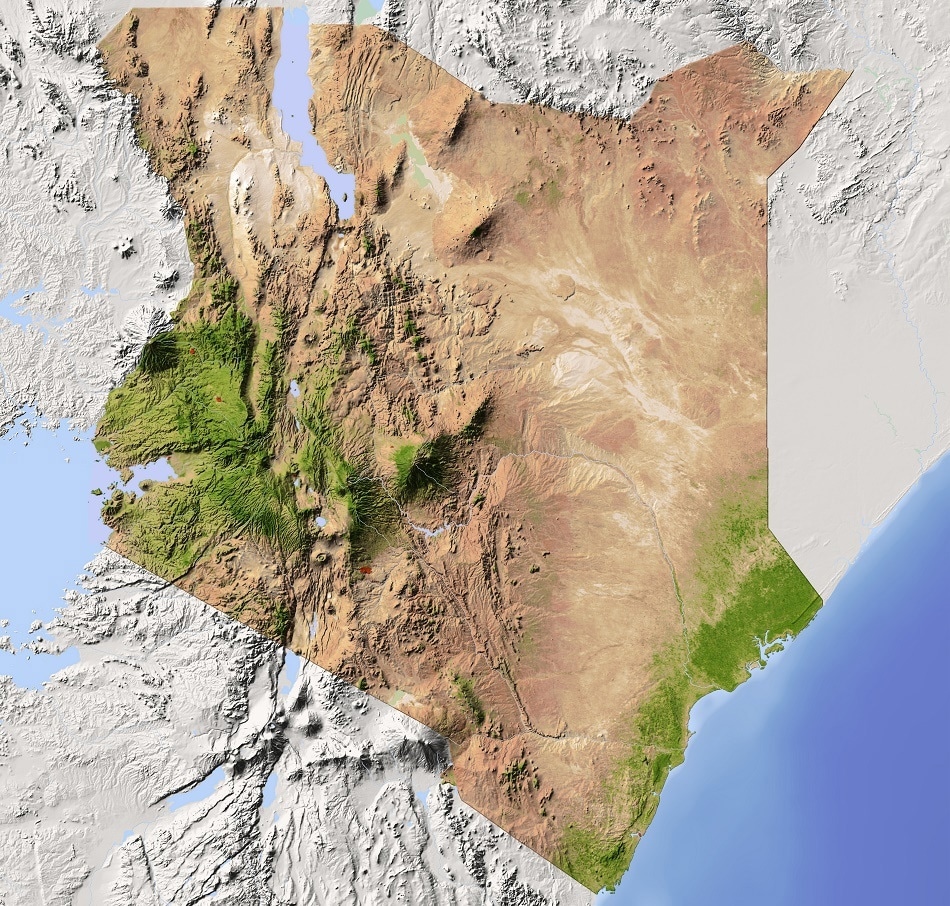Sep 17 2012

Image Credits: AridOcean/shutterstock.com
Kenya is located in Eastern Africa between Tanzania and Somalia. The total area of the country is 581,309 km2 and has a population of roughly 48 million. The country’s climate varies from tropical along the coast to arid in the interior regions. The GDP of the country was $76.07 billion in 2012.
Kenya is the economic, transport and financial of East Africa. Since 2014, Kenya has been ranked as a lower middle-income country, as its per capita GDP crossed a World Bank threshold. Previously, The World Bank and IMF restricted aid to the country previously due to rampant corruption. Kenya has a growing entrepreneurial middle class and steady growth, but its economic development has been impaired by weak governance, political instability, corruption and violent clashes between rival parties since gaining independence in 1963.
The natural resources of Kenya include oil, gas, limestone, gypsum, soda ash, diatomite, gemstones, fluorspar, zinc, wildlife, and hydropower. The country is gearing up to move from an agriculture and tourism based-economy to one that is based on mineral resources. Most of the mines and cement plants are privately owned.
Overview of Resources
Mineral resources in Kenya include gold, iron ore, talc, soda ash, some rare earth minerals, and gemstones. Gold is mostly restricted to the westernmost part of the country, while areas around Mombasa host limestone, niobium, iron ore, gemstones, and salt.
The mining and quarrying sector in Kenya accounts for less than 1 percent of gross domestic product, with the majority being contributed by the soda ash operation at Lake Magadi in south-central Kenya. In 2010, Kenya’s share of the world’s soda ash production amounted to 4%. Cement, fluorspar, and petroleum refining were the other mining and mineral processing activities undertaken by the mining sector.
The future production statistics of fluorspar, gemstones, and soda ash will depend greatly on world market conditions.
Metals
In 2010, Aviva Corporation Ltd. of Australia signed a joint-venture agreement with Lonmin plc of UK to explore for copper, gold, silver, and zinc in the Ndori Greenstone Belt. In the same year, Base Resources Ltd. of Australia acquired the Kwale mineral sand reserves from Vaaldiam Mining Inc. of Canada.
Devki Steel Mills Ltd. owns three steel plants with a combined capacity of 250,000 Mt/yr. Devki has plans to build another steel mill with a capacity of 1 million Mt/yr.
Pacific Wildcat Resources Corp. (PAW) of Canada has started a drilling program at the Mrima Hill niobium and rare-earth elements project.
Industrial Minerals and Gemstones
There are five cement producers in Kenya with a combined capacity of 5.7 Mt/yr. The country’s cement production increased to 3.71 Mt in 2010 from 3.32 Mt in 2009. The cement plant owned by Athi River Mining Ltd. (ARM) at Kaloleni has a capacity of 300,000 t/yr. The company has also started operating another plant with a capacity of 730,000 t/yr at Athi River since December 2010. Mombasa Cement produced 300,000 t of cement in 2010 compared to 250,000 t in 2009.
Cement production is set to increase as the existing plants and the newly constructed plants are likely to increase their capacity. The demand for cement in other African countries such as Tanzania, Burundi, Rwanda, and Uganda will also have an impact on cement exports from Kenya.
Magadi Soda Ash Ltd. mined at the Lake Magadi and soda ash production increased to 473,689 t in 2010 from 404,904 t in 2009. Almost 84% of Magadi’s output was exported during the years 2005 to 2009.
Fossil Fuels
Africa Oil Corp. of Canada had shown interest to conduct drill exploration of the oil wells on Blocks 10A and 10BB in the first half of 2011.
Investment
The mining sector in Kenya is all set to expand to a greater level in the coming years as the recent increase in global demand for minerals has seen several Australian and other mining companies seeking permission from the Kenyan government to explore its mineral reserves.
The first ever large-scale mine in the country, Kwale mineral sands mine operated by Base Resources of Australia will aid in spurring the growth of the country's poorly developed mining sector.
All these developments are very promising for the future of Kenya’s mining sector. It is now up to the government to sort out the internal political issues and pave the way for economic growth by strengthening its mining sector.
2013 Kwale Mineral Sands Project
Kwale Mineral Sands is located in Kenya, approximately 40km south of Mombasa. The mine’s development is estimated to cost $298m, and construction began in 2011. The mine began production of ilmenite and rutile in December 2013, with the production of zircon commencing in February 2014. Annual production is projected to be 330,000t of ilmenite, 80,000t of rutile and 40,000t of zircon.
The project is predicted to be one of the top producers of ilmenite and rutile in the world, with production amounting to 14% of the global supply of these minerals. It is expected to generate $1bn in revenues in the mineral sands market over 13 years.
2016 Kenyan Mining Act
The 2016 Mining Act replaced the former 1940 mining act. The previous act contained out-of-date laws and mining data, which meant that the country had missed out on potential mineral exploration. The new legislation includes more details and provisions about the principles of land policy, public land, regulation of land use and property, environmental obligations and agreements relating to natural resources.
Mining Minister Dan Kazungu wrote a new strategy that spans over the 20 years, with the hopes that 10% of GDP will come from mining by 2030. The new strategy includes plans for up to 20 new mines and aims to have 20 more operators situated in the country over the next 15 years.
References
This article was updated on 31st October, 2018.